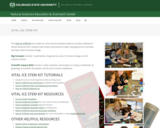About every two weeks I ask each student in my introductory course to
write brief responses to questions I pose to them. They write these in
an e-Journal, a part of the blog function of BlackBoard. My laboratory
instructor and I use their responses to learn about the background and
interests of students in the class, to assess how well they are
learning, to determine if group work is going well, and to give us
ideas for improving the course.
The following two eJournal question sets are part of a course, Marine Environmental
Geology, a non-majors science course that has a significant service
learning component. The semester long service learning projects that
accompany this course require constant monitoring.
Assessing Service Learning Project Work The set of questions just below
is designed to have students think outside the group context about what
concrete steps need to be done to finish the work of their service
learning project. We read these and respond very quickly, supporting
good ideas. During the following week we encourage each group to come
together and share what they have written in Part 1. Writing their
thoughts down and having them supported by faculty helps some students
who normally don't express their ideas in a group to try out their
ideas with their peers.
The second question asks the student to reflect upon their own work and
work effort and helps us learn if there are any potential problems
within groups.
This week's e-journal is a follow-up to the presentations & lab we
did this week. The first part, goals & help needed, should be
written as a bulleted list with concrete objectives. The second part
should be answered in brief paragraph format.
The data collection phase of the projects is complete, or for some
groups, almost complete. While project work will carry on independently
through the end of the semester, we only have one more week in lab
devoted to it.
Part 1
After reviewing where you stood at the time of your presentation and
what you accomplished in lab this week, what do you intend to do with
the remaining lab period? What analyses do you hope to complete before
you present your results to the class in November? What help do you
need to meet these objectives?
Part 2
How do you feel about your project at this point? What do you feel you
did well? Are there any places you think you could have done better,
either personally or as a team?
Assessing Mastery of Content and Concepts
Last year I used this question to learn what specific problems students
were having with course material before an exam. By asking them to use
"use textbook vocabulary and to use it precisely" I am forcing them to
dig into material and be very specific about what they don't
understand. Sometimes students will write a very careful paragraph and
at the end say, "I understand it now." That doesn't always happen, so
for the most part I see what gets voted for most frequently and weave
that into the next lecture.
Critical Concepts Question
Thus far I have covered topics in my lectures which depend on the
following Critical Concepts sections in your textbook
CC1 Density
CC4 Particle size/sinking
CC6 Salinity, temp, etc
Read through these sections and write about the one that you had the
greatest difficulty understanding. Be specific about what you don't
understand. Be very careful to use textbook vocabulary and to use it
precisely. Write no more than three paragraphs
(Note: this resource was added to OER Commons as part of a batch upload of over 2,200 records. If you notice an issue with the quality of the metadata, please let us know by using the 'report' button and we will flag it for consideration.)

